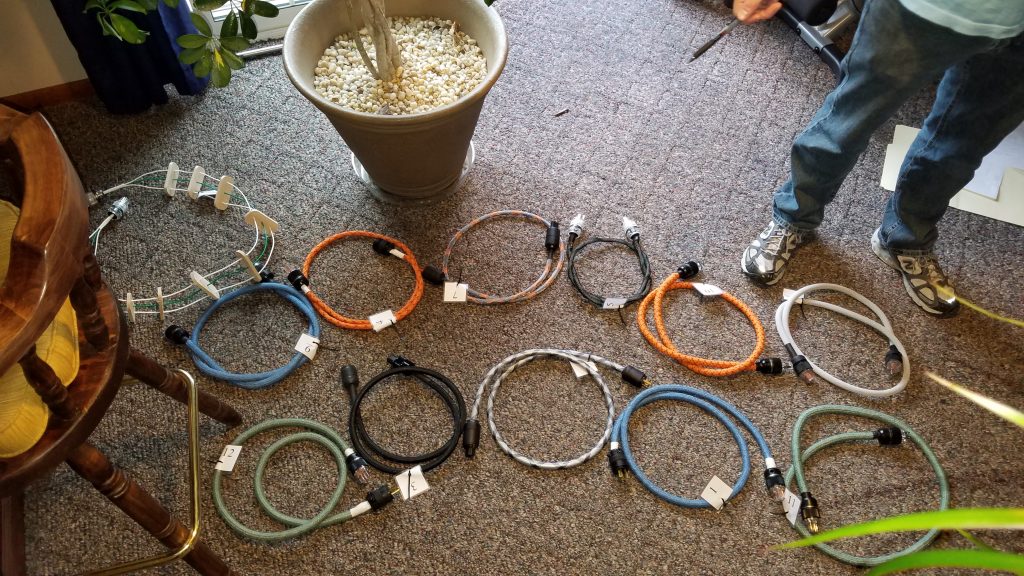The days in one’s lifetime are few and far between when something you’ve believed as “set in stone” is completely turned on its head.
In the not so distant past, I was convinced that a 12 AWG ‘standard’ power cord would carry current quite sufficiently for my audio amplifiers and equipment…and it probably is as my gear is not the best.
My viewpoint comes from a background in electrical engineering, copious amounts of electronics theory study, accompanied with years of experience from designing and installing car audio, to residential power wiring from the time I was strong enough to use a set of wire strippers. Add my career in building automation controlling 3-phase pumps, chillers, and air handling units, in addition to the many family dinners where my brother and I would have discussions about power transmission lines (my younger brother followed in my footsteps and has become a stamped electrical engineer dealing with power transmission in underground coal mines and pipeline refineries). Well, you can say that I have dealt with my fair share getting power from one place to the next.
I elaborate about my experience only to build upon my credibility of electrical and electronics knowledge, because what I am about to admit to you is that, at one point in time, not too long ago, I firmly believed that power cords, couldn’t, shouldn’t, and wouldn’t make a difference in an audio system. This conviction was based on mostly experience and beliefs mind you. My belief was fairly strong and overall mostly geared toward high end audio equipment. After all, when you purchase a piece of high-end gear, what are you paying for if not a very well-regulated power supply?
I was one of those guys that would say things like…“listen, it’s aluminum wire from the poles to your panel box,” then, “probably a thin piece of copper with tinned contacts on the breaker to cheap recycled copper to your outlet. To say that the last meter or few feet of conductor that the power touches is going to significantly affect the transmission of the power, much less actually affect the sound of the stereo…No, I don’t think so.”
So, it goes without saying that I was completely dumbfounded when I personally experienced for myself the profound difference that a power cable can have on a stereo system (and a fairly high end one to boot).
The day this belief changed for me was a long time coming. Let me give you some background on this scenario. One day I get a call from a friend (we were practically family before the company) and he says to me that he and another audio friend have made some power cords. They would like me to listen with a few other people (all of whom have become Finley Audio) to a sizeable batch of power cords that they made. With my predetermination to essentially go and giggle at them when we heard nothing, I thought it to be at least worth my time to appease them and enjoy a beverage or two afterward.
But as it turned out, this was not your average listening session.
Usually when someone gets a new piece of gear or makes a tweak to their system it’s an enjoyable time to listen to each other’s gear.
This time was not the case. No, this was a purpose-built day dedicated for critical listening to a half a dozen power cords that they considered to be better than what you could buy for anywhere near the price point that they had built them. They wouldn’t even allow a drink until we were done! I suppose they did not want it to cloud our judgement (or maybe because it was before noon). Whether it was because they had put so much time and effort into building the cables or that they believed that they had stumbled onto some “magic pixie dust” that would allow your system to perform at its best or maybe because they were just not that confident in their own ears, but for whatever reason we were taking this much more seriously than normal.
Testing procedures were laid in a fashion of a double-blind test. I had brought along my lovely wife who was kind enough to lend her time for the day to become our very own cable ‘switcher-outer’. I should say she’s not unaccustomed to power and transmission (between then and now she has become an audio power transmission coordination technician), so she had an idea what we were doing. She would pick a cable from the pile and place it in the system noting the cable ID number on her notepad. We, however, only knew that it was the 1st or 2nd or 3rd, etc. cable that we had listened to. I was even unaware if there were actually any difference at all in the cables. They said there was, in some way a difference to each, but was that really true?
So, let the games begin!
We began listening to five or so carefully selected song passages, less than one minute each, to expose one facet of sound or another. These were played on a loop with each cable, same tracks, same order, same volume.
By the third cable I stopped listening entirely.
I zoned out to reflect upon all my beliefs over my 30 some years I have been on this earth. Had everything I knew about electronics been a lie? Was this even my reality? Am going to I wake up barely remembering this profound experience in a cold sweat (aka was I dreaming)?
Then once the pause between the songs broke the silence, I was fully awake and entirely re-engaged. I continued listening intently. I could not get enough of what I was hearing, not necessarily because it was hearing if ‘this’ cable was better or worse than the ‘last’ cable, but because of the vast differences between each cable. I continued listening, hearing differences and jotting down my notes for each cable. Upon completion of the test, this was a test after all, I put my name at the top and like a good student turned it into the teacher.

Immediately after, and once a libation or two was consumed, we began to discuss and ponder the exponential number of variables that come into play when creating and implementing power cords in an audio system. The guys that built these first few prototypes began explaining some of the things that they had found to make significant sonic differences on a few different audio systems. One even found that it had made his microwave work better! OK, just kidding.
Another notable piece of information that cemented what I had heard was the fact the no less than all of us heard differences in each design and 75% of us involved heard and noted the same exact things. That’s a passing score where I went to school! So, I’m not the only one hearing this (and/or am crazy)! And I passed!
This day was for me a very memorable and enlightening experience. The kind that makes you ponder life itself (or at least our knowledge of electrical theory).
That day is also what would be known as the beginning of Finley Audio.
We have worked very hard to produce a line of products that we feel is a better sounding cable than you can buy for the same price from anyone else. This is subjective however, so I encourage you to listen for yourself. But I am confident that you will in fact – at the very least – hear the difference a cable can make.
